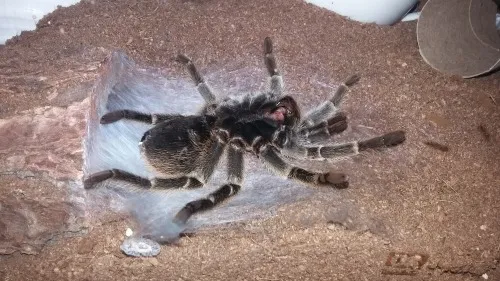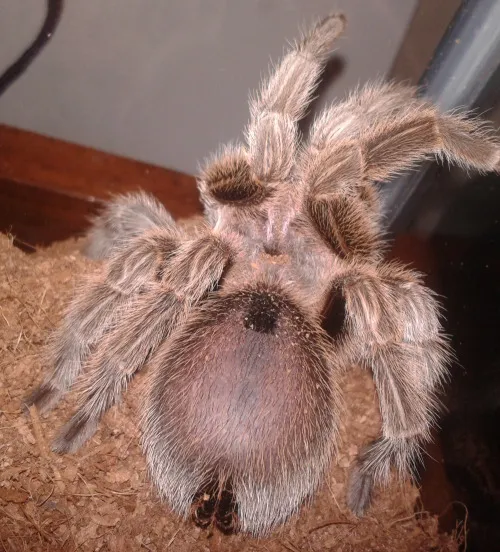What is Premolt in Tarantulas
Premolt is a crucial stage in a tarantula’s life cycle, signaling that the arachnid is preparing to shed its exoskeleton. This process, also known as molting, allows the tarantula to grow and replace its old, worn-out outer layer with a new one. During premolt, the tarantula undergoes significant internal and external changes. The old exoskeleton starts to detach from the new one forming beneath. The tarantula will appear less active and may display several telltale signs, indicating that it’s about to undergo this transformative process. Understanding the premolt phase is essential for tarantula keepers to provide appropriate care and avoid unnecessary stress to their pets. The duration and specific characteristics of premolt can vary depending on factors like the tarantula’s species, age, and environmental conditions.
Signs Your Tarantula is in Premolt
Recognizing the signs of premolt is key to ensuring the well-being of your tarantula. Several behavioral and physical changes will indicate that your tarantula is preparing to molt. These signs can vary slightly depending on the species and individual tarantula, but being familiar with them can help you anticipate the molt and provide the necessary environment. Keep a close eye on your tarantula’s behavior and appearance to catch these early indicators, and adjust your care accordingly. The following signs are among the most common and noticeable.
Refusal of Food

One of the most common signs of premolt is a tarantula’s refusal to eat. Even if you offer its favorite meal, it will show no interest. This is because the tarantula’s energy is focused on preparing for the molt, not on feeding. The tarantula’s appetite typically decreases significantly or vanishes entirely. The time frame of food refusal can vary, sometimes starting weeks or even months before the actual molt. While this can be worrying, it is completely natural during premolt, and you shouldn’t force feed. Continue to offer food at regular intervals, but remove it after a while if it’s not eaten, to prevent uneaten prey from stressing the tarantula.
Lethargy and Inactivity
During premolt, tarantulas often become less active and spend more time in their hide or burrow. Their movements will become slower and less frequent. They may also appear sluggish when disturbed. This is due to the energy-intensive process of preparing for the molt, as well as the physical changes occurring beneath the exoskeleton. The tarantula will generally avoid unnecessary movement to conserve energy. The level of lethargy can vary. Some tarantulas may remain visible but still move very little, while others might completely disappear from view, indicating that they are going into premolt. Always provide a safe and undisturbed environment during this period.
Darkening of the Abdomen
Another noticeable sign of premolt is the darkening of the tarantula’s abdomen. This change in color is caused by the new exoskeleton forming beneath the old one. The old exoskeleton is starting to detach from the new exoskeleton. The darkening usually occurs gradually and may be more pronounced in certain species. In some tarantulas, you might also observe a bald spot on their abdomen, which may appear darker due to the thinning of the old exoskeleton in preparation for the molt. Monitoring the abdomen’s appearance is a helpful way to assess the progress of the premolt stage.
Changes in Behavior

Apart from the above signs, you may also notice behavioral changes. The tarantula may become more reclusive, spending most of the time hidden in its burrow. It could also become more irritable and defensive if disturbed. Some tarantulas may seal off their burrow entrance with webbing, creating a secure environment. The tarantula will try to find a safe place to molt. These behavioral changes are all indications that the tarantula is preparing for a vulnerable state. Avoid handling or disturbing your tarantula during this time and provide a calm, stable environment to minimize stress.
How Long Does Premolt Last
The duration of the premolt stage can vary significantly depending on several factors, making it difficult to give an exact timeframe. While there’s no precise answer to ‘how many days does tarantula premolt last?’, understanding the influencing factors can help you manage your expectations and provide the appropriate care. Premolt can range from a few weeks to several months. Some tarantulas may show signs of premolt for a relatively short period, while others may take much longer before they finally molt. The variations are normal, and it is more important to monitor the signs of premolt than to focus on a specific duration.
Factors Affecting Premolt Duration
Several factors influence how long a tarantula spends in premolt. Each tarantula will react a bit differently. Therefore, the duration can differ significantly between individual tarantulas and species. Understanding these factors can help you understand and anticipate the process. Some of the most impactful factors are mentioned below.
Species of Tarantula

Different tarantula species have varying molting cycles and premolt durations. Fast-growing species might experience shorter premolt periods and molt more frequently, especially during their juvenile stages. Slower-growing species, such as some of the larger, more long-lived tarantulas, may have longer premolt periods. Some species will show more obvious premolt signs, while others may undergo the process more subtly. Researching your tarantula’s specific species can provide insight into its molting patterns and help you anticipate what to expect.
Age of the Tarantula
A tarantula’s age is a significant factor. Juvenile tarantulas molt much more frequently than adults, sometimes every few months. During this stage, premolt periods tend to be shorter. As the tarantula matures, the molting frequency decreases, and the premolt periods can lengthen. Adult tarantulas, especially older ones, may molt only once a year or even less frequently. The older the tarantula gets, the more careful you should be. Premolt can be challenging for older tarantulas, which is why you need to maintain a stress-free environment.
Environmental Conditions
The environment in which the tarantula lives also plays a role. Optimal conditions can support a smoother molting process, while unfavorable conditions can cause stress, potentially prolonging premolt. Maintaining proper temperature and humidity levels is crucial. Ensure that the enclosure is not too dry or humid for the species. Also, providing a safe and undisturbed environment is important. Avoid handling the tarantula during premolt and minimize vibrations and disturbances near the enclosure. A stable, stress-free environment helps the tarantula prepare for and complete its molt efficiently.
Molting Process

The molting process is a remarkable event to witness, but it is best to observe it from a distance to avoid disturbing your tarantula. Once the premolt stage is complete, the tarantula will begin the actual molting process. The tarantula will usually flip onto its back. This position helps the tarantula to extract itself from its old exoskeleton. The tarantula’s body will then start to expand and contract, breaking the old exoskeleton and gradually pulling itself out. The process can take several hours, depending on the size and health of the tarantula. The newly molted tarantula will be soft and vulnerable. Therefore, it’s important to provide a safe and undisturbed environment.
Post-Molting Care
After molting, the tarantula’s new exoskeleton will be soft and its fangs will be delicate. The tarantula will need time to harden and its fangs to harden. It is very important not to disturb the tarantula and avoid feeding it for several days or even a week. The tarantula will be very vulnerable during this period, so handling should be avoided. Provide fresh water and maintain the appropriate temperature and humidity levels. After a week or two, the tarantula’s fangs and exoskeleton will have hardened. At this point, you can start offering small meals. Observe how the tarantula behaves and gradually increase the meal size. After molting, the tarantula is essentially a new tarantula, with a fresh start.
